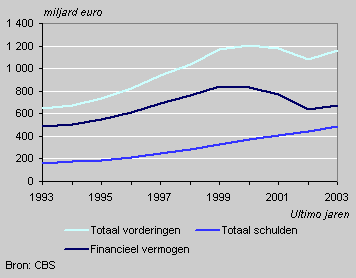Households not yet recovered from stock market crash

The financial capital of Dutch households rose by an average 9.4 percent in the period 1994–1999, to 840 billion euro. Subsequently this capital decreased by one quarter in the period 2000–2002 as a consequence of the crash on the stock exchange. Although a slight improvement was observed in 2003, households have not yet recovered from the crash: their financial capital is still 20 percent smaller than in 1999.
Assets and liabilities of households, 1993–2003

Stock market crash still noticeable
The sharp drop in financial capital in 2001 and 2002 can be attributed to the enormous losses of households on the stock exchange. They lost money on both their own shares and on their pension and life insurance investments. In 2003 share holdings of households amounted to 128 billion euro, compared with 264 billion euro in 2000. Pension and life insurance provisions amounted to 661 billion euro, 2.6 percent more than in 2000.
Safe savings
As a result of the sustained stock market losses in recent years and the continuing instability on the market, more households are playing safe. Bond ownership rose from 29 billion to 48 billion euro in the period 2000–2003. Risk-free savings balances rose by an average 11.6 percent per year in the period 2001–2003. This is more than twice the average yearly increase in the period 1998–2000. Households had more than 187 billion euro in savings accounts in 2003. In the first four months of 2004, too, they still tended towards saving.
Higher mortgage debts push up total debt
Debts of households rose by an average 12 percent a year in the last ten years. In 2003 the total amount of debt was 490 billion euro. Most of this amount consisted of outstanding mortgage loans: 407 billion euro. On the other side of the balance there was a larger amount of non-financial assets, such as the value of the mortgaged homes. In 2003 nearly 90 percent of owner -occupied homes were mortgaged.
Financial balance sheet for households, 31 December 2003

Taking stock
The financial balance sheet for Dutch households for 2003 shows that 57 percent of financial assets consisted of pension reserves. Some 16 percent consisted of risk-free savings balances and 15 percent of riskier stock exchange securities. On the side of the balance, there are liabilities amounting to 42 percent of assets. The financial capital of households therefore amounted to 58 percent of their assets.
Bert Kal